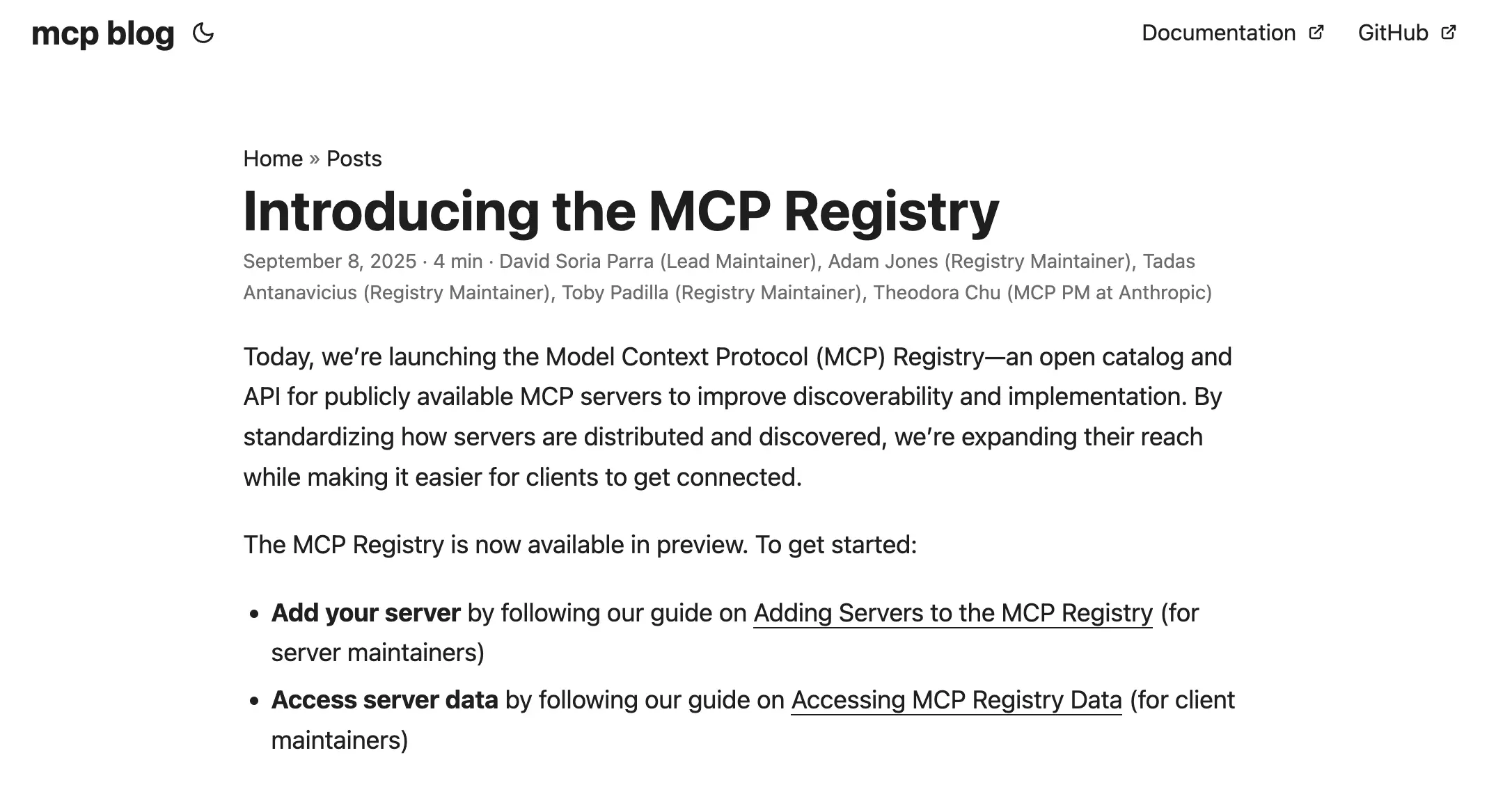MCP Registry Architecture: A Technical Overview
A deep dive into the MCP Registry's architecture, exploring design decisions, implementation details, and the sophisticated systems that enable standardized server distribution while maintaining flexibility for custom implementations.
The Model Context Protocol (MCP) Registry helps AI applications discover and connect to context providers. Explore the architecture, design decisions, and implementation details that make the MCP Registry both powerful and extensible.
The Model Context Protocol (MCP) Registry offers a structured mechanism for AI applications and tool clients to discover and connect to MCP servers.
First launched in preview in September 2025, the registry aims to reduce fragmentation in the MCP ecosystem by providing a shared metadata catalog of servers. It is designed to support extension and federation, so that organizations can build custom sub-registries while conforming to a consistent interface.
This technical deep dive explores the architecture, design decisions, and implementation details that make the MCP Registry powerful.
The Problem Space
Before the registry existed, MCP clients and ecosystem actors maintained disparate catalogs, enterprises built ad hoc internal registries, and server authors lacked a standard publishing path.
This led to duplicated effort, inconsistent metadata views, and discovery friction. The registry’s goal is to act as a primary source of truth for MCP server metadata, while allowing downstream systems to curate or extend as needed.

Core Components & Architecture
Registry API & Metadata Model
The MCP Registry is delivered as an open catalog + API, backed by an OpenAPI specification.

Server maintainers publish metadata describing each MCP server (endpoint, capabilities, versioning, and related fields). The registry enforces minimal validation (e.g. namespace uniqueness, schema conformance) to maintain a reliable catalog.
The metadata model is intentionally extensible so that additional properties (tags, categorization, curation data) can be layered by subregistries or tooling.
Namespace / Ownership Verification (Proposed, Not Yet Public)
The registry intends to validate namespace ownership to prevent impersonation (this is highlighted in planning discussion), though the public preview does not fully document all mechanisms. A future design may include:
- GitHub-based namespace publishing (e.g. io.github.username/*) authenticated via OAuth.
- Domain namespaces (e.g. com.example/*) validated via DNS or HTTP proof (e.g. TXT records or challenge endpoints).
These would allow server publishers to prove control over a namespace before registering a server under it.
Federation & Sub-Registries
One of the registry’s key architectural decisions is to embrace federation: the upstream MCP Registry is not the only registry. Instead, it serves as the canonical source of public MCP server metadata that subregistries (public or private) can ingest, augment, or mirror.
- Public subregistries (e.g. marketplaces tied to specific clients) can enrich metadata (user ratings, audit info, search filters).
- Private subregistries within enterprises can combine published servers with internal ones, apply custom policies, and share a consistent API surface with MCP clients.
To ensure compatibility, subregistries are expected to reuse the OpenAPI schema and metadata contracts defined by the upstream registry.
Validation, Trust & Integrity (Vision)
The registry announcement does not currently describe cryptographic or package-level validation logic. But a plausible extension architecture might look like:
- The upstream registry verifies namespace ownership and schema correctness (metadata-level trust).
- Downstream subregistries or clients can overlay additional validation (e.g. verifying servers’ manifests, signing keys, or hashes).
- Clients may do final integrity or signature checks on server responses or tool payloads.
If the ecosystem expands to include MCP-specific package formats or integration with software package registries (npm, PyPI, OCI, etc.), the registry could provide hooks or validation metadata, but this is future vision—not part of public preview.
Remote Server Capabilities & Deployment
The registry focuses on discovery, not running or auditing MCP servers themselves. It stores metadata about the server endpoints (including transport protocol support, authentication requirements, etc.).
Clients use that metadata to connect to those MCP servers via standard MCP mechanisms (e.g. streamable HTTP, SSE, or other transport). The registry does not proxy or mediate runtime traffic.
Server metadata may include declarations of required authentication headers or credentials, so clients know in advance which auth scheme to use.
Moderation & Governance
The registry is open source and community maintained. Users can flag servers via GitHub issues if entries are malicious, spammy, or impersonating legitimate services.
Registry maintainers can denylist or remove such entries. This hybrid human + automated moderation model balances safety and openness.
Performance, Scalability & Evolution
To handle growth, the registry may adopt caching strategies (e.g. TTLs, ETag/conditional requests), pagination, and efficient search. Because it deals mainly with metadata, the performance burden is lower than a full package registry.
Schema versioning enables the registry to evolve its metadata contract over time, while maintaining backward compatibility.
Limitations & Risks
- Because the preview registry does not yet guarantee data durability or stability, breaking changes or resets are possible.
- The registry’s trust boundary is limited to metadata. It does not (in the preview) enforce cryptographic validation of server payloads or tools.
- Debugging validation or trust failures across heterogeneous MCP servers or subregistries may require cross-system coordination.
- If subregistries diverge too wildly (e.g. adding incompatible extensions), fragmentation could creep back in.
Summary
The MCP Registry introduces a foundational infrastructure component for the MCP ecosystem: a shared metadata catalog that supports discovery, curation, and federation. Its preview release defines a minimal but extensible framework.
As the registry matures, layering in integrity verification, cross-registry validation, and package support may become part of the formal specification, but they are not yet documented in the preview.